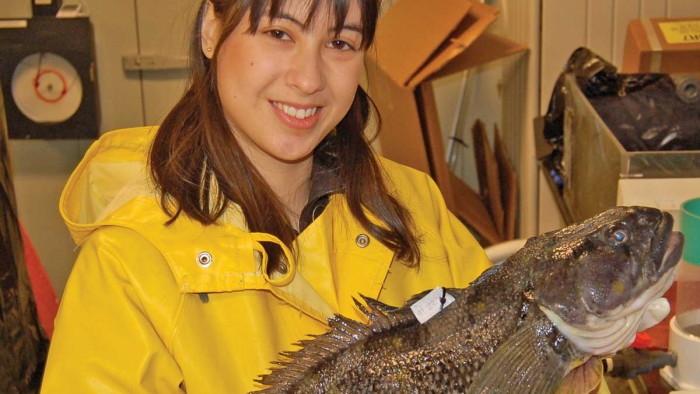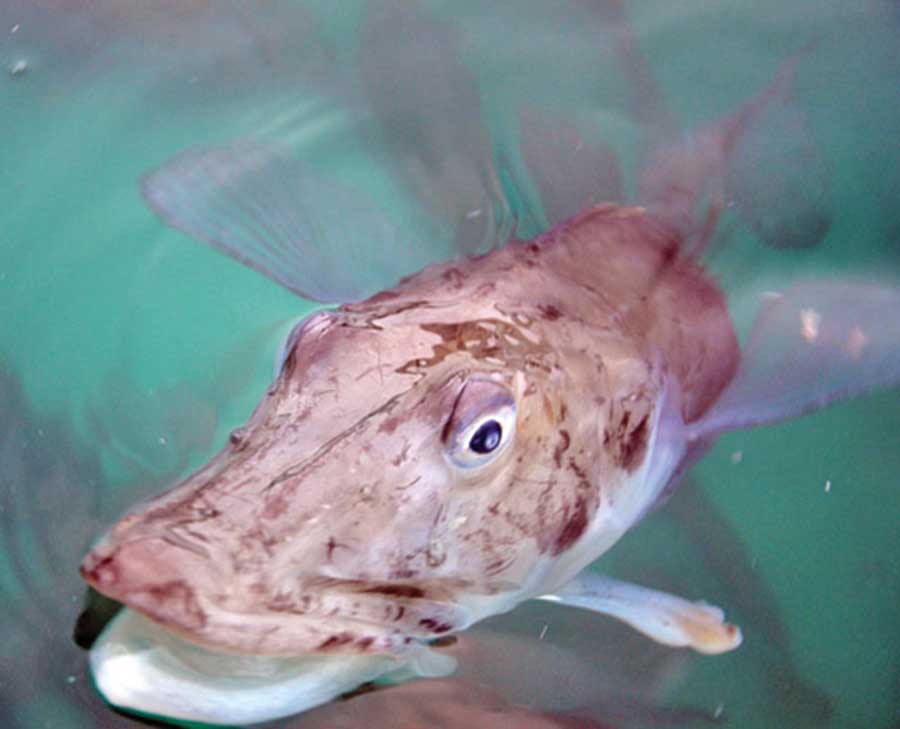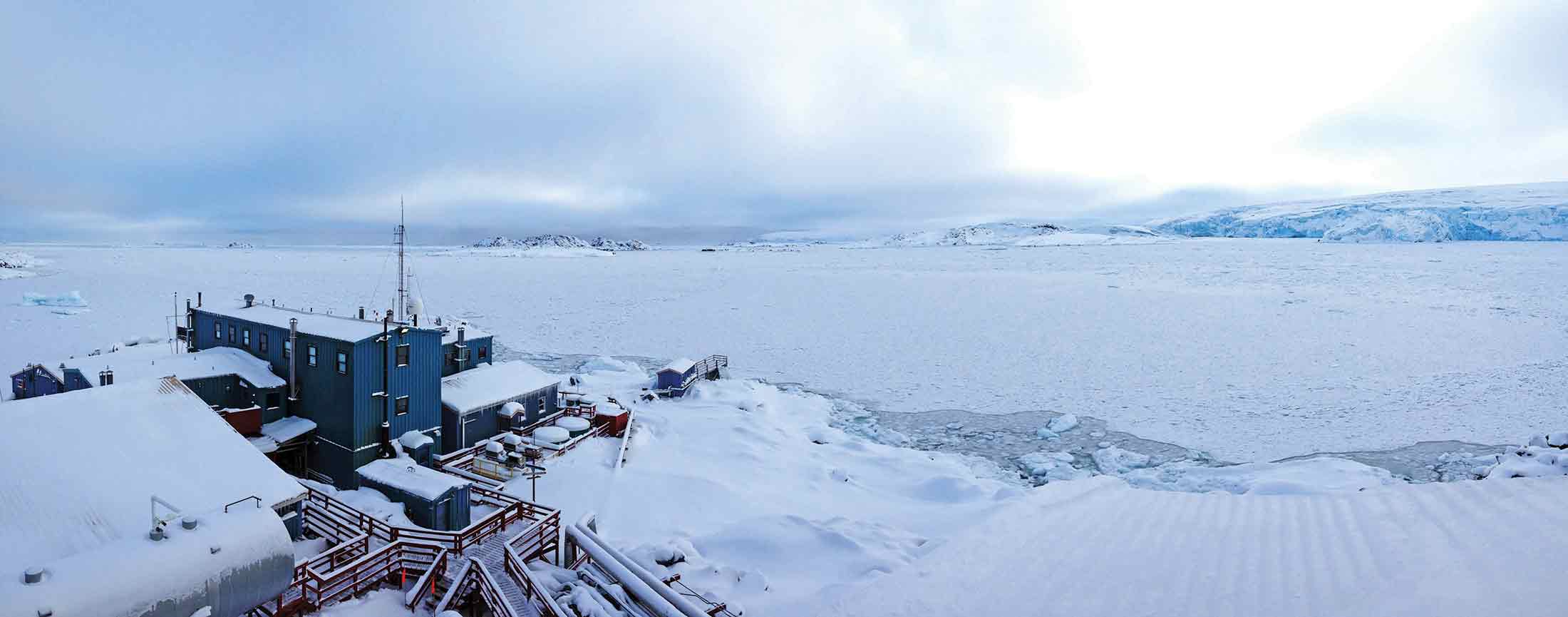 Natural Sciences
Natural Sciences
A “Winterover” in Antarctica

Recent UO grad Ashley Nelson, with a rockfish, during her sojourn at Palmer Station. Rockfish are used as a comparator or control in the icefish study. They have a standard bone density structure, so UO scientists can compare the DNA of the rockfish to blackfin icefish to help narrow down genetic factors at play in making icefish bones so much lighter.
It’s not the sort of thing you’d expect in a marine biology major. But the truth is, Ashley Nelson tends to get seasick.
But, oh, the places where she’s been sick.
The recent UO graduate (above, with a rockfish) spent summer 2013 at Palmer Station, Antarctica, working as a research assistant for biology professor John Postlethwait. That meant a four-day, 750-mile boat ride from Punta Arenas, Chile, to the tip of the Antarctic peninsula—through some of the roughest seas on the planet. But for Nelson, it was worth it.
First, there was the scenery. The station sits at the foot of the Marr Ice Piedmont, where cliffs of iridescent blue loom behind the cluster of metal-clad buildings, a scene Nelson described in an email to her parents when she arrived in May 2013.
“The first thing I saw was the Marr glacier right behind the station,” she said. “I told them that I’d never seen ice that blue, and that it was absolutely beautiful and serene.”
At 64 degrees south latitude, Palmer Station actually is above the Antarctic Circle, which means it doesn’t get quite as dark for quite as long as bases closer to the South Pole. Winter in Antarctica coincides with summer in the Northern Hemisphere, so Nelson saw her daylight limited to about four hours a day of twilight while her friends here were enjoying the longest days of the year.
But the polar landscape was anything but boring. Even with the short days, Nelson and her crewmates had regular chances to get out and explore, hiking and showshoeing to the top of the nearby glacier or roving about in inflatable Zodiac boats. Penguins and seals were common sights, and once a huge flock of hundreds of cormorants did a 360-degree circle around her and some companions, putting them in the center of a vortex of birds.
“There’s no words to describe it, other than it was out of this world,” she said.
Then there was the job. Being a research assistant isn’t always the most glamorous work, but Nelson would be responsible for key parts of an ongoing project with implications in the treatment of bone diseases such as osteopenia, a predecessor of osteoporosis, and anemia, which is a loss of red blood cells.
And to do that, Nelson would become that most hardy type of Antarctic researcher, the “winterover.” A winterover stays at the research station through the long, dark Antarctic winter, when bases are reduced to skeleton crews after the departure of scientists and support staff members who flock to the polar region during the summer season.
Nelson’s job, along with that of a few others, was to collect data and keep the lab running during the slow winter season. Postlethwait and two colleagues at Northeastern University, professor Bill Detrich and postdoctoral fellow Jeffrey Grim, are studying cold-water fish to learn more about how their development and genetics can bolster knowledge of human disease.
In particular, they’re looking at the blackfin icefish (below), an odd, white-blooded species that developed without the swim bladder other fish use to stay buoyant. To compensate, the icefish evolved a fragile but very lightweight bone structure that could aid understanding of human bone development.
species that developed without the swim bladder other fish use to stay buoyant. To compensate, the icefish evolved a fragile but very lightweight bone structure that could aid understanding of human bone development.
Results suggest that icefish end up with such light and fragile bones because genes that cause bones to be more robust in other species don’t turn on, Postlethwait said. That could be similar to what happens in elderly people who develop osteoporosis, which is why studying icefish is worth these long treks into the polar wilderness.
“This is likely what happens in some elderly people—they have bone mineralization genes, but these genes stop working as these people get older,” Postlethwait said. “If we can find out the molecular nature of the DNA changes in icefish that lead to the failure to regulate bone mineralization genes, we can provide hints as to what might be happening in the elderly that are susceptible to bone loss diseases.”
And to learn that, the researchers need to study icefish embryos. Enter Nelson, a budding marine biologist who never thought of herself as much of an adventurer or risk-taker. But that was before her adviser at the Oregon Institute of Marine Biology told her about an opening in Postlethwait’s lab. A chance to do science at an Antarctic research station in winter? She jumped, and never looked back.
“I kind of surprised myself by actually going and doing that,” she said. “I learned a lot. Not just from the program, but also what I could do myself. I learned that I can do a lot more than I think I can.”
 A typical day at Palmer (left) started with Nelson “waking the fish,” which are caught in the ocean nearby and kept in tanks fed by seawater. The lab varies the lighting in its fish tanks to mimic natural sunlight and encourage breeding. Nelson looked for females that appeared ready to lay eggs, caught them and massaged their bellies to get the eggs. Next, she would find males to get the sperm needed to fertilize the eggs. Last, she put egg and sperm together in an incubator to begin producing embryos for research.
A typical day at Palmer (left) started with Nelson “waking the fish,” which are caught in the ocean nearby and kept in tanks fed by seawater. The lab varies the lighting in its fish tanks to mimic natural sunlight and encourage breeding. Nelson looked for females that appeared ready to lay eggs, caught them and massaged their bellies to get the eggs. Next, she would find males to get the sperm needed to fertilize the eggs. Last, she put egg and sperm together in an incubator to begin producing embryos for research.
Nelson arrived at the base before the summer crew left, so she learned the routine before being left to handle things along with the other assistants. Even so, the regular contact with professors through the Internet and satellite phones turned out to be vital.
One day, Nelson woke to discover that a pump had failed overnight on one of the lab’s five fish tanks. Without the pump, oxygen levels in the water plummeted and nearly all the fish in the tank died. The winter crew contacted Postlethwait and the other scientists and developed a plan to replace them.
That put Nelson back on the water, this time on a fishing vessel stationed at Palmer. She made it through that day without too much queasiness and the lab got its fish and stayed on schedule.
While many schools target graduate students for research jobs, the UO actively recruits undergraduates for these truly cutting-edge opportunities, Postlethwait said. Nelson was one of two undergraduates who spent the winter at Palmer, and she said she feels “honored” to have been entrusted with so much responsibility so early in her career.
Nelson had all the qualities needed for the job, Postlethwait said. In addition to her extensive experience with the UO’s marine biology institute, she brought the right attitude to a difficult job.
“Ashley is a quiet but cheerful person, and that’s essential for working with the same 20 people you can’t get away from in constant darkness and numbing cold,” he said. “Also, and more important, she brings a smile to work with her every day.”
The trip was more than physically and mentally demanding; it also forced Nelson to make tough decisions. A student in the Robert D. Clark Honors College, she was on track to graduate in spring 2013, but she chose to delay graduation for a year to take advantage of the opening.
She returned last October—the return voyage to Punta Arenas was much rougher than the trip into Palmer Station, and she spent most of it in her bunk—and finished her honors thesis that fall. She still marvels at the turn her life took when she signed on for the expedition.
“A year and a half ago I would never have believed that I was going to Antarctica,” she said. “It was too good of an opportunity to pass up.”
—Greg Bolt


 Twitter
Twitter Facebook
Facebook Forward
Forward